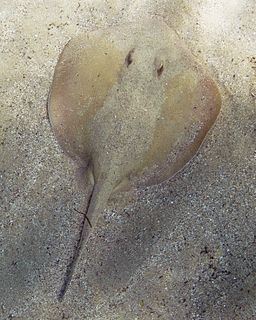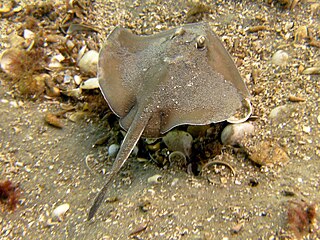See also
- Captain Stingaree, a DC Comics villain
The Stingaree was a disreputable neighborhood of San Diego at the turn of the 20th century. The word may also refer to:
In entertainment:
Places:
Other:
Kai or KAI may refer to:

The Urolophidae are a family of rays in the order Myliobatiformes, commonly known as stingarees or round stingrays. This family formerly included the genera Urobatis and Urotrygon of the Americas, which are presently recognized as forming their own family Urotrygonidae. Stingarees are found in the Indo-Pacific region, with the greatest diversity off Australia. They are sluggish, bottom-dwelling fish that have been recorded from shallow waters close to shore to deep waters over the upper continental slope. Measuring between 15 and 80 cm long, these rays have oval to diamond-shaped pectoral fin discs and relatively short tails that terminate in leaf-shaped caudal fins, and may also have small dorsal fins and lateral skin folds. Most are smooth-skinned, and some have ornate dorsal color patterns.

The deepwater stingray or giant stingaree is a species of stingray and the sole member of the family Plesiobatidae. It is widely distributed in the Indo-Pacific, typically over fine sediments on the upper continental slope at depths of 275–680 m (900–2,230 ft). This species reaches 2.7 m (8.9 ft) in length and 1.5 m (4.9 ft) in width. It has an oval pectoral fin disc with a long, flexible, broad-angled snout. Most of the entire latter half of its tail supports a distinctively long, slender, leaf-shaped caudal fin. Its coloration is dark above and white below, and its skin is almost completely covered by tiny dermal denticles.

The thorntail stingray, black stingray, or longtail stingray is a species of stingray in the family Dasyatidae. It is found off southern Africa, Australia, and New Zealand from the intertidal zone to a depth of 440 m (1,440 ft). This bottom-dweller inhabits soft-bottomed habitats such as lagoons, estuaries, and reefs. Growing to 1.8 m (5.9 ft) across and over 200 kg (440 lb) in weight, the thorntail stingray is among the largest stingrays in the world. Uniformly dark above and light below, it has a diamond-shaped pectoral fin disc and a very long, whip-like tail with a fin fold underneath. The upper surface of the disc and the tail bear numerous stout, sharp thorns.

The short-tail stingray or smooth stingray is a common species of stingray in the family Dasyatidae. It occurs off southern Africa, typically offshore at a depth of 180–480 m (590–1,570 ft), and off southern Australia and New Zealand, from the intertidal zone to a depth of 156 m (512 ft). It is mostly bottom-dwelling in nature and can be found across a range of habitats from estuaries to reefs, but also frequently will swim into open water. One of the largest stingrays in the world, this heavy-bodied species can grow upwards of 2.1 m (6.9 ft) across and 350 kg (770 lb) in weight. Its plain-colored, diamond-shaped pectoral fin disc is characterized by a lack of dermal denticles even in adults, and white pores beside the head on either side. The body can have colors as well as dark grey or black with rows of white spots along each wing. Its tail is usually shorter than the disc and thick at the base. It is armed with large tubercles and a midline row of large thorns in front of the stinging spine which has the dorsal and ventral fin folds behind.

Paul Causey Hurst was an American actor and director.
The masked stingaree is a common species of stingray in the family Urolophidae, endemic to southwestern Australia. It prefers moderately deep areas of sand or seagrass some distance from shore, though it can be found in very shallow water or to a depth of 115 m (377 ft). The masked stingaree can be identified by the two large, dark blotches on the upper surface of its rounded pectoral fin disc, one of which encompasses its eyes like a mask. The outer rims of its nostrils are expanded into prominent lobes, while between the nostrils is a skirt-like curtain of skin with a deeply fringed trailing margin. Its tail bears a small dorsal fin just before the stinging spine, and end in a leaf-like caudal fin. This species grows up to 31 cm (12 in) across.
The yellow shovelnose stingaree is a little-known species of stingray in the family Urolophidae, endemic to the outer continental shelf off Western Australia at a depth of 100–210 m (330–690 ft). Growing to 39 cm (15 in) long, this species has an oval pectoral fin disc with a rather elongated, triangular snout, and a short tail with a caudal fin but no dorsal fin. There are prominent lobes outside of its nostrils, and a skirt-shaped flap of skin with a deeply fringed trailing margin in between. Above, this ray is an almost completely uniform light to dark yellow color, which darkens on the caudal fin. The International Union for Conservation of Nature (IUCN) assesses the yellow shovelnose stingaree as least concern, as there is minimal fishing within its range.

The eastern shovelnose stingaree is a species of stingray in the family Urolophidae, endemic to coastal waters off southeastern Australia, excluding Tasmania. This species has a rounded pectoral fin disc wider than long, a fleshy snout forming an obtuse angle, and a relatively short tail terminating in a caudal fin. Its nostrils have prominent lobes on their outside rims and a skirt-shaped curtain of skin with a strongly fringed trailing margin between them. The dorsal coloration is mostly plain brownish, occasionally with a scattering of darker and/or lighter spots. One of the larger stingarees, it can grow to at least 80 cm (31 in) long.

The common stingaree is a species of stingray in the family Urolophidae. The most abundant ray in inshore waters off eastern Australia, it generally inhabits estuaries, sandy flats, and rocky reefs from the shore to a depth of 60 m (200 ft). This plain brownish to grayish species has a rounded pectoral fin disc with a broadly triangular snout. Its nostrils have enlarged lobes on their outer margins and a skirt-shaped curtain of skin with a fringed posterior margin between them. Its tail bears a small dorsal fin before the stinging spine, and terminates in a leaf-shaped caudal fin. This ray can grow to 52 cm (20 in) long.

Urolophus is a genus of round rays mostly native to the western Pacific Ocean and the Indian Ocean, though one species occurs in the Pacific waters of the Mexican coast. Müller and Henle erected Urolophus in an 1837 issue of Bericht Akademie der Wissenschaften zu Berlin. The name is derived from the Greek oura, meaning "tail", and lophos, meaning "crest". In Urolophus, the outer rims of the nostrils are not enlarged into lobes, but may form a small knob at the back.

The sandyback stingaree or great stingaree is a little-known species of stingray in the family Urolophidae, endemic to southeastern Australia. It is generally found offshore around the edge of the continental shelf, at a depth of 65–265 m (213–869 ft). A relatively large species reaching 89 cm (35 in) long, the sandyback stingaree has a diamond-shaped pectoral fin disc wider than long, usually with a dorsal pattern of numerous fine lighter marks on a yellowish to brownish background. Its short tail terminates in a deep, leaf-shaped caudal fin, and bears a sizable dorsal fin just in front of the stinging spine.
The Kai stingaree is a species of stingray in the family Urolophidae, known only from two juveniles collected from 236 m (774 ft) deep in the Kai Islands of eastern Indonesia. This species has a rhomboid pectoral fin with a very blunt, rounded snout, and a tail with lateral skin folds, a leaf-shaped caudal fin, and no dorsal fin. It is brown above with blackish coloring on the upper surface of each eyeball. The larger of the two specimens measures 23 cm (9.1 in) long. The International Union for Conservation of Nature (IUCN) does not yet have enough information to assess the Kai stingaree beyond Data Deficient. It presently faces little fishing, though this is liable to change in the future.
The New Caledonian stingaree is a little-known species of stingray in the family Urolophidae, found off New Caledonia and the adjacent Chesterfield Islands and Norfolk Ridge. This species reaches 37 cm (15 in) long and has a rounded, diamond-shaped pectoral fin disc slightly wider than long. There is a skirt-shaped curtain of skin between its nostrils. Its tail is fairly long, lacks a dorsal fin, and ends in a leaf-shaped caudal fin; some individuals also bear slight lateral skin folds on the tail. The International Union for Conservation of Nature (IUCN) has listed the New Caledonian stingaree under Least Concern, as it faces no substantial fishery threats.

The sparsely-spotted stingaree, also known as the white-spotted stingaree or Dixon's stingaree, is a species of stingray in the family Urolophidae, common off the southern Australian coast. Preferring sandy flats and seagrass beds, this benthic ray can be found from close to shore to a depth of at least 150 m (490 ft), and tends to occur deeper in the northern portion of its range. Reaching a length of 57 cm (22 in), this species has a broad, diamond-shaped pectoral fin disc that is typically plain gray in color above with a V-shaped marking between the eyes. Individuals from southerly waters also generally exhibit a smattering of small, dark-edged white spots. This ray is further characterized by a distinctively bell-shaped curtain of skin between the nostrils. Its tail has a skin fold running along either side and a leaf-shaped caudal fin, but no dorsal fin.
The Coral Sea stingaree is a little-known species of stingray in the family Urolophidae, found at a depth of 171–310 m (561–1,017 ft) around the edge of the continental shelf off northern Queensland. Growing to a length of 48 cm (19 in), this species has a diamond-shaped pectoral fin disc with a protruding snout and a skirt-shaped flap of skin between the nostrils. Its tail bears a low dorsal fin before the stinging spine and terminates in a short leaf-shaped caudal fin. Its upper surface is grayish or brownish, sometimes with tiny dark spots. The Coral Sea stingaree may represent two closely similar species, one large and one small. There is very little fishing activity within its range, and thus it has been listed under Least Concern by the International Union for Conservation of Nature (IUCN).

Stingaree is an American pre-Code romantic drama film directed by William A. Wellman released by RKO Radio Pictures in 1934. The film was based on a 1905 novel by Ernest William Hornung. Set in Australia, it stars Irene Dunne as Hilda Bouverie and Richard Dix as Stingaree. Hollywood had previously filmed the Hornung story as serials in 1915 and 1917, starring True Boardman.
Stingaree is a 1915 American drama film serial, set in Australia, directed by James W. Horne. It was followed by a sequel The Further Adventures of Stingaree.
Brown stingray may refer to:

Stingaree is a 1905 novel by E. W. Hornung about an Australian bushranger. It was allegedly based on the Kelly Gang.